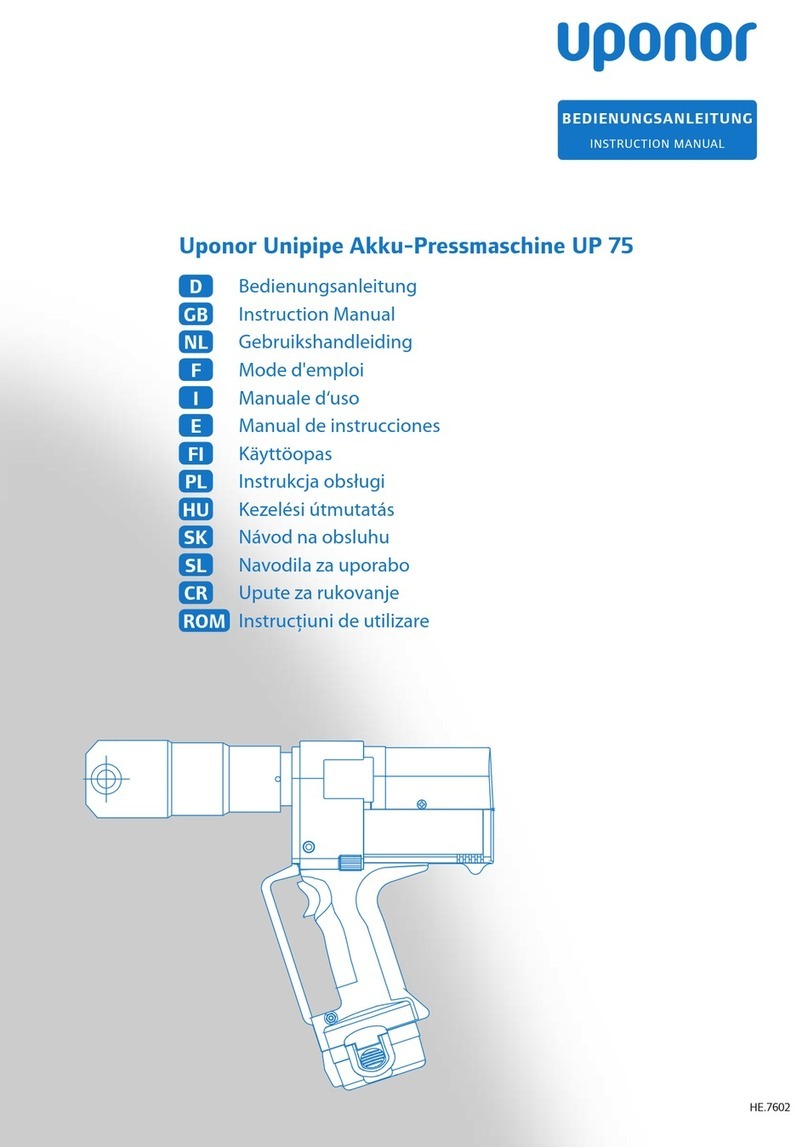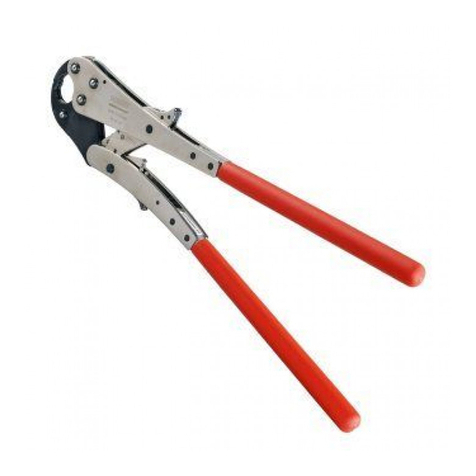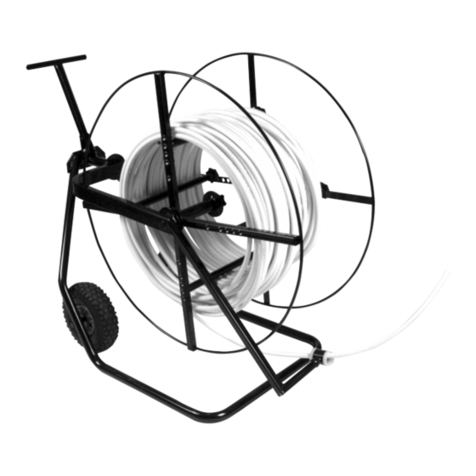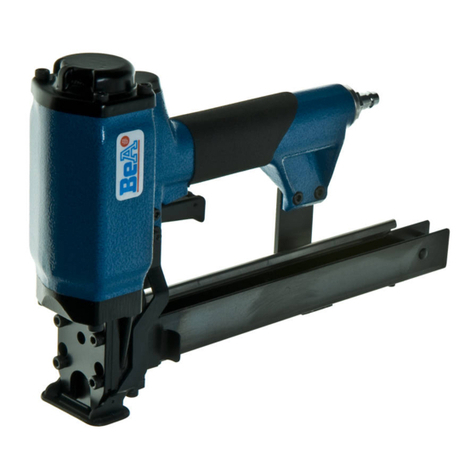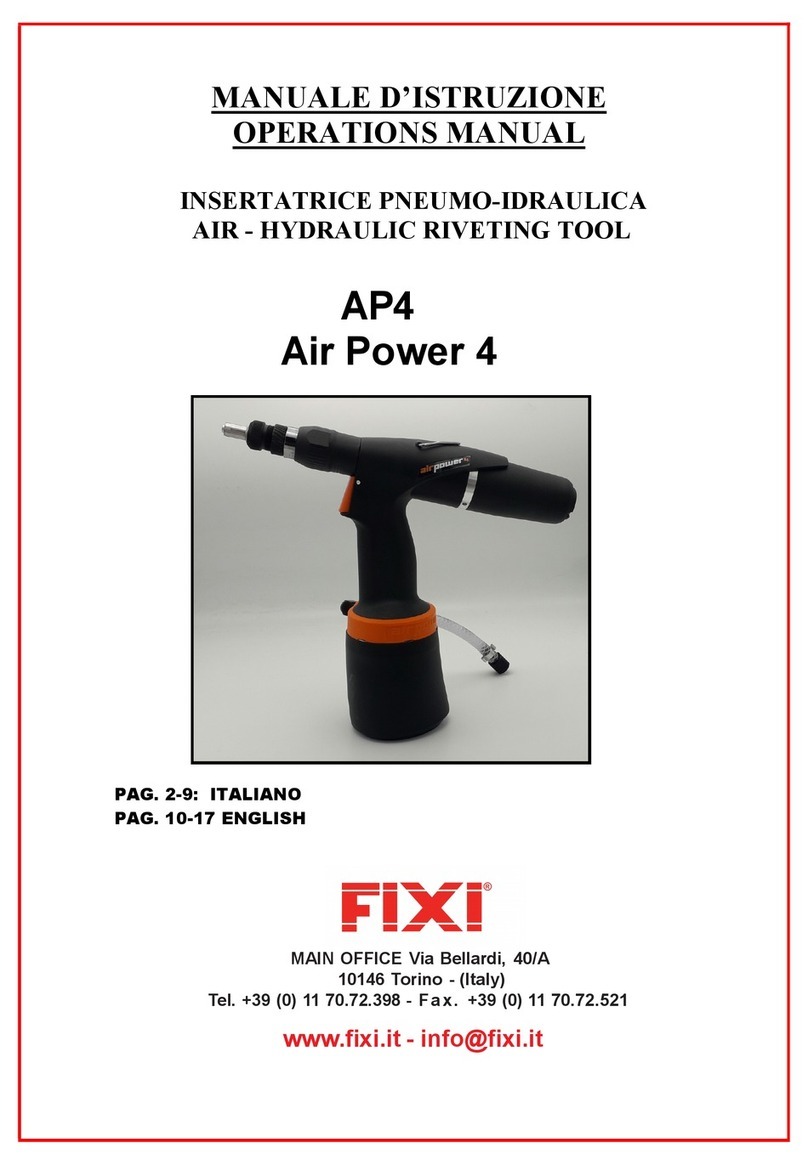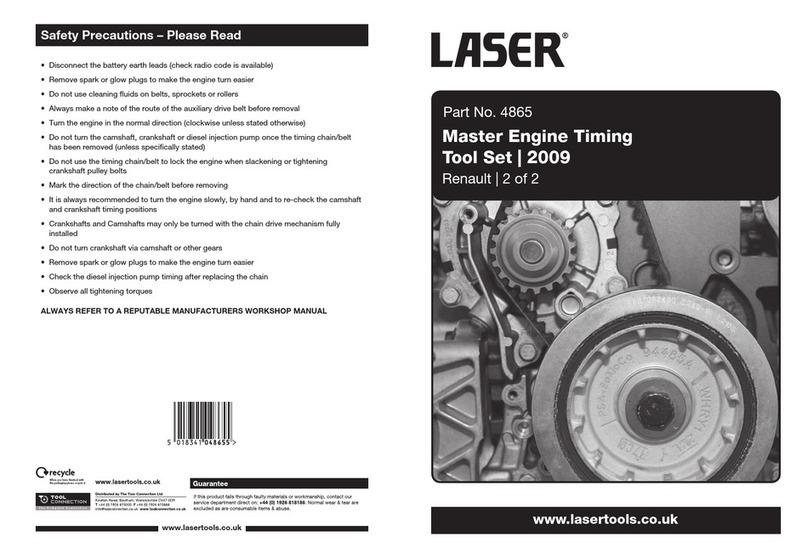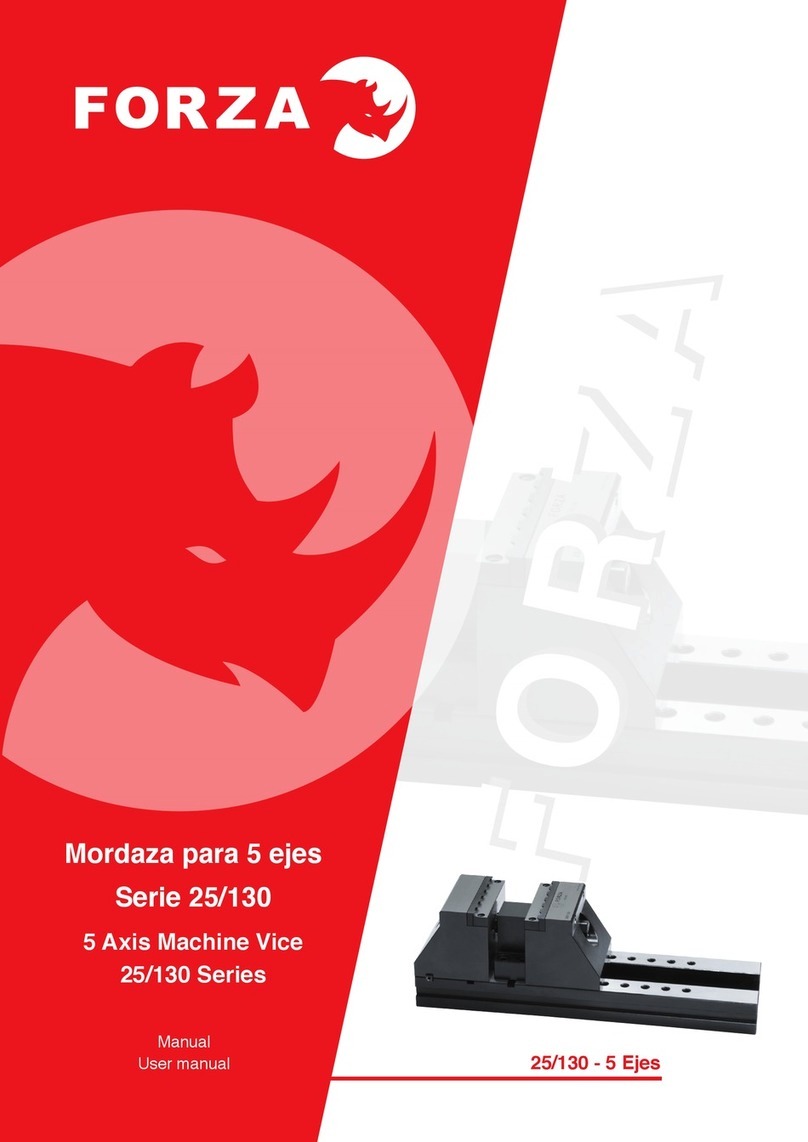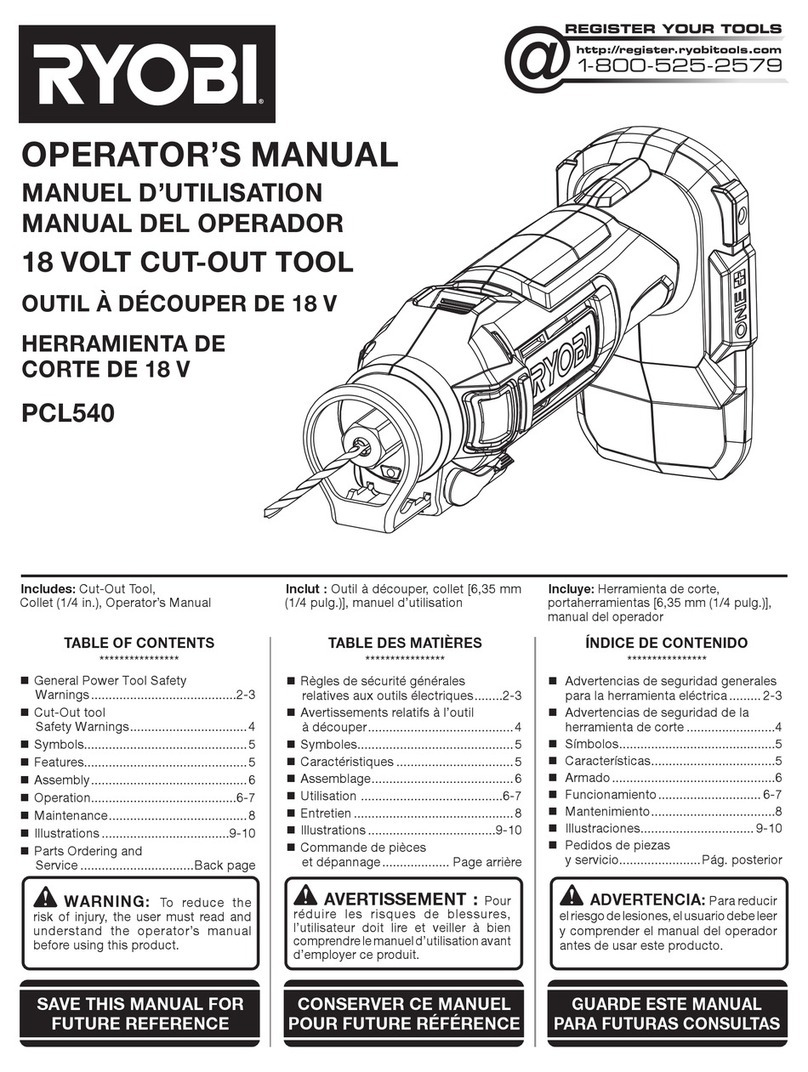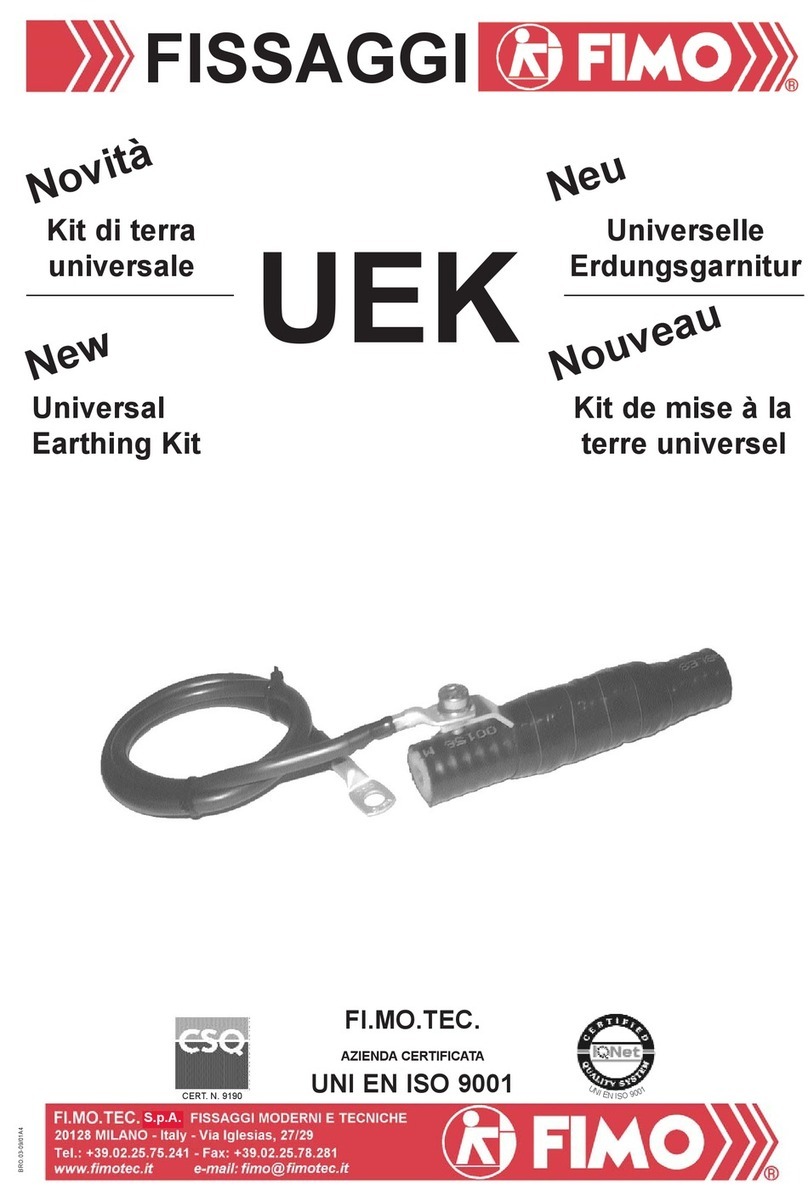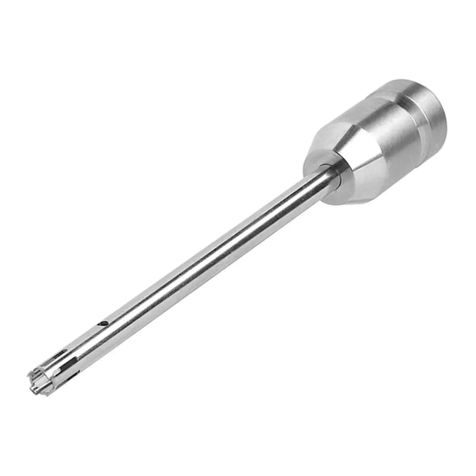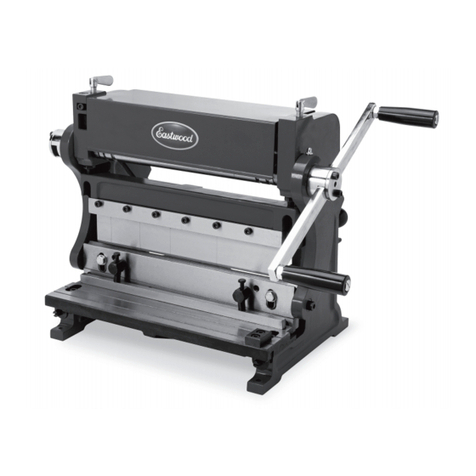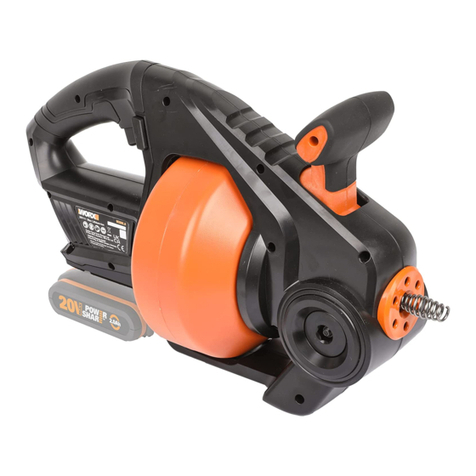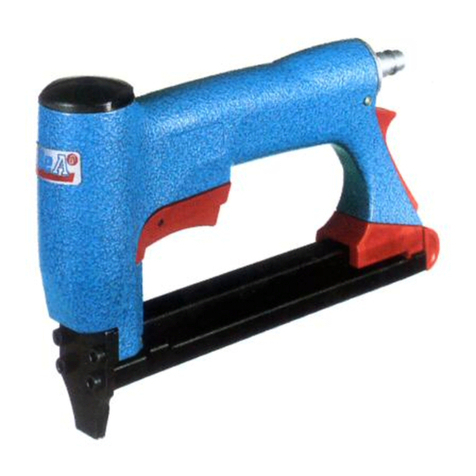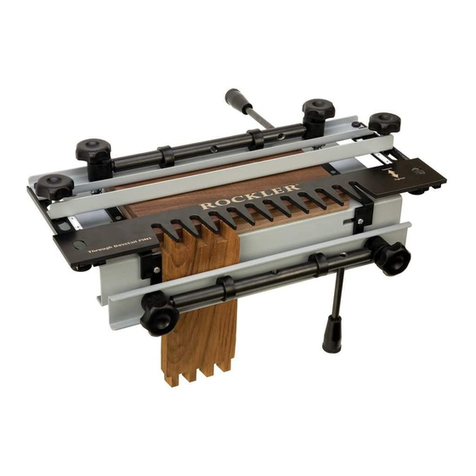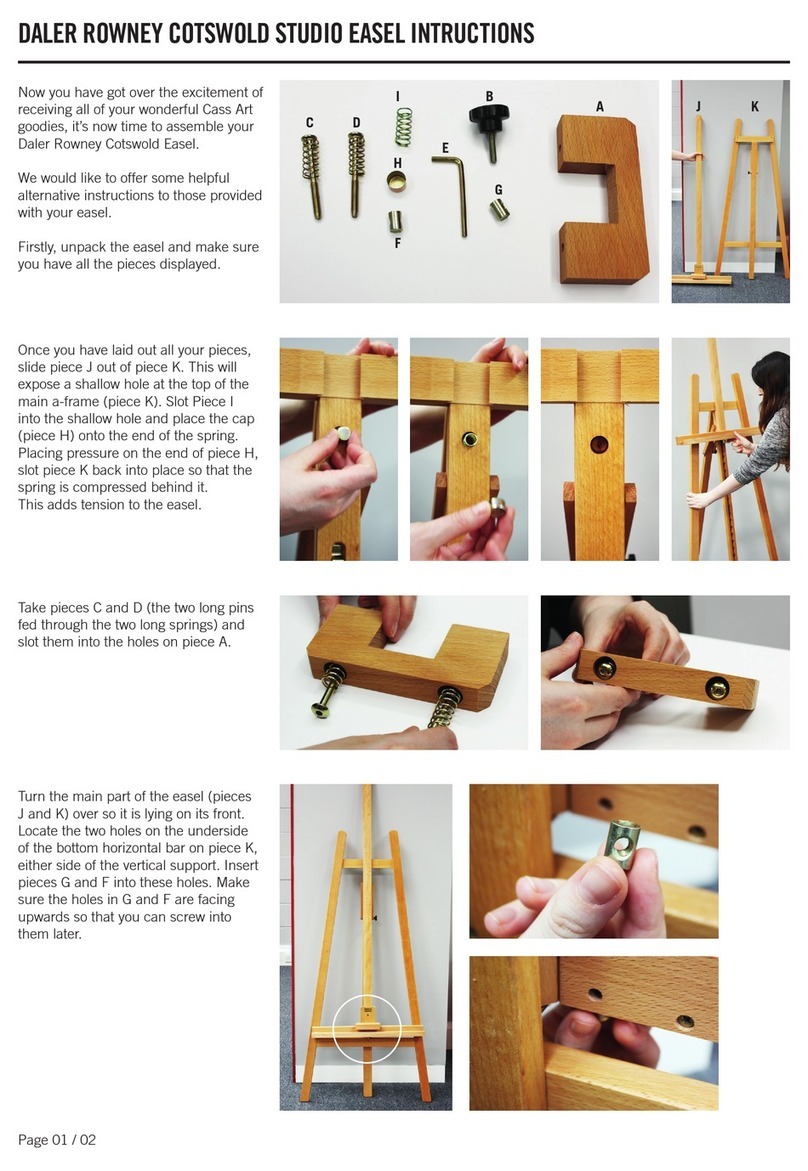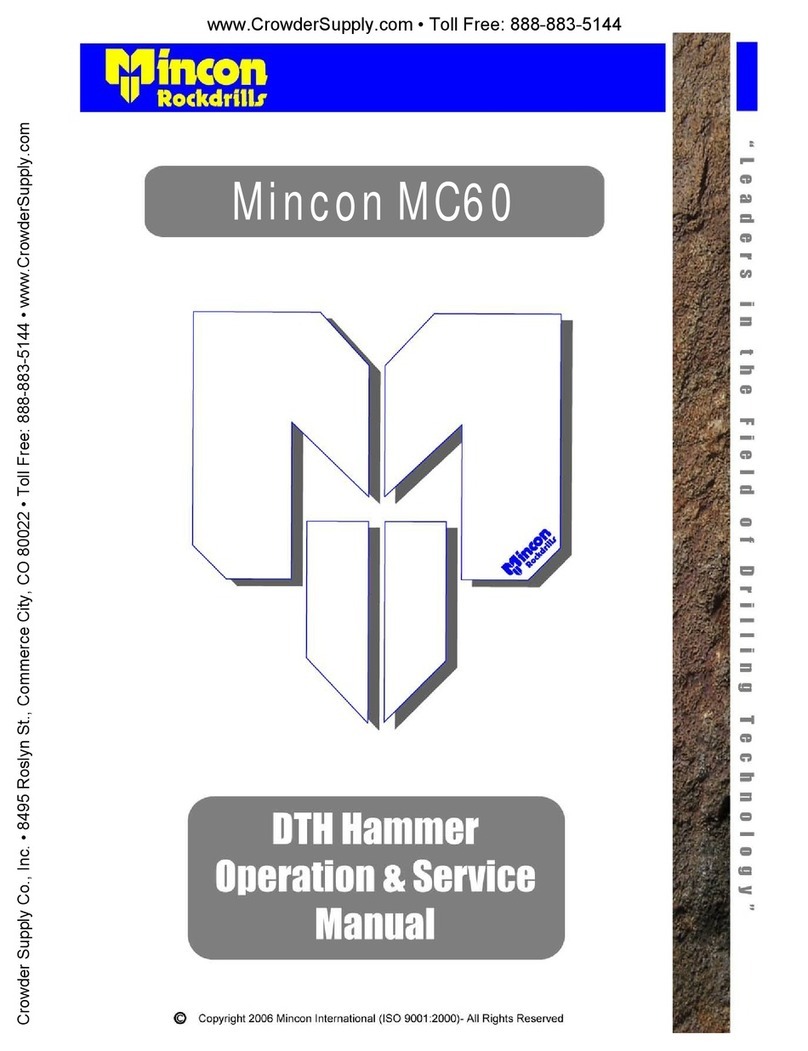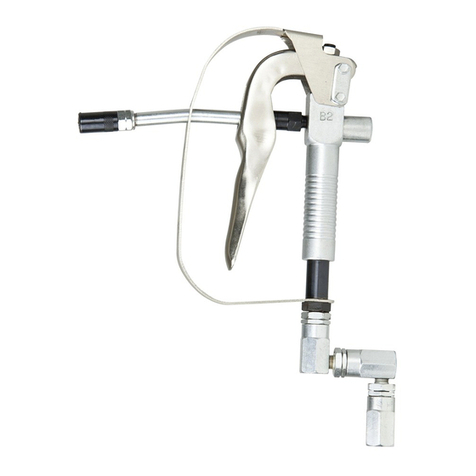Uponor Mini-Press Battery Tool User manual

OPERATION MANUAL
Connecting up to 1"
Uponor Multi-layer
Composite (MLC) Tubing
MiniPressTool_OMHB_10-07, Copyright ©2007 Uponor, Printed in the United States
RADIANT HEATING SYSTEMS
MINI-PRESS BATTERY TOOL
Uponor,Inc.
5925 148th Street West
Apple Valley, MN 55124
Tel: (800)321- 4739
Fax:(952)891
-1409
Web: www.uponor-usa.com

i
Mini-Press Battery Tool Operation Manual
This Operation Manual is published for builders and contractors
interested in Uponor radiant heating systems. This manual describes
general installation recommendations that use Uponor Multi-layer
Composite (MLC) tubing (formerly MultiCor®) and corresponding MLC
tubing fittings (formerly MultiPress™). Be sure to follow local
code requirements.
Uponor has used reasonable efforts in collecting, preparing and
providing quality information and material in this manual. However,
system enhancements may result in modification of features or
specifications without notice. For the most current technical information,
go to the Uponor website at www.uponor-usa.com.
Uponor is not liable for installation practices that deviate from this manual
or are not acceptable practices within the mechanical trades. Refer to the
Uponor Radiant Floor Heating Installation Handbook for proper installation
methods for Uponor MLC tubing.
Please direct any questions regarding the suitability of an application or a
specific design to your local Uponor representative. For the name of your
local representative, call toll free (800) 321-4739.
Mini-Press BatteryTool Operation Manual
Published by Uponor,Inc.
5925 148th Street West
Apple Valley, MN 55124
(800) 321-4739
www.uponor-usa.com
©2007 Uponor, Inc.
All rights reserved
First Edition
First Printing January 2007
Printed in the United States of America
www.uponor-usa.com

iii
Mini-Press Battery Tool Operation Manual
Table of Contents
Section 1 – Overview
Tool Kit Components . . . . . . . . . . . . . . . . . . . . . . . . . . . . . . . . . . . . . . . 1
Important Information . . . . . . . . . . . . . . . . . . . . . . . . . . . . . . . . . . . . . . 1
Section 2 – Technical Data .............................3
Section 3 – Battery Operation
Charging the Battery . . . . . . . . . . . . . . . . . . . . . . . . . . . . . . . . . . . . . . . 5
Battery Handling . . . . . . . . . . . . . . . . . . . . . . . . . . . . . . . . . . . . . . . . . . .5
Charging Indicators . . . . . . . . . . . . . . . . . . . . . . . . . . . . . . . . . . . . . . . . .6
Section 4 – Tool Operation and Guidelines
Installing and Changing Press Jaws . . . . . . . . . . . . . . . . . . . . . . . . . . . . .7
Tool Operation . . . . . . . . . . . . . . . . . . . . . . . . . . . . . . . . . . . . . . . . . . . .7
Tool Guidelines . . . . . . . . . . . . . . . . . . . . . . . . . . . . . . . . . . . . . . . . . . . .8
Tool Maintenance ..........................................8
Troubleshooting . . . . . . . . . . . . . . . . . . . . . . . . . . . . . . . . . . . . . . . . . . .9
Safety Guidelines .........................................10
Repairs . . . . . . . . . . . . . . . . . . . . . . . . . . . . . . . . . . . . . . . . . . . . . . . . .10
Warranty . . . . . . . . . . . . . . . . . . . . . . . . . . . . . . . . . . . . . . . . . . . . . . . .11
Section 5 – Making MLCPress Fitting Connections
Installation Guidelines . . . . . . . . . . . . . . . . . . . . . . . . . . . . . . . . . . . . . .13
Tools Needed . . . . . . . . . . . . . . . . . . . . . . . . . . . . . . . . . . . . . . . . . . . . .13
Preparing the MLC Tubing . . . . . . . . . . . . . . . . . . . . . . . . . . . . . . . . . .13
Installing the MLC Press Fitting . . . . . . . . . . . . . . . . . . . . . . . . . . . . . .14
Installing MLC Sweat Fittings . . . . . . . . . . . . . . . . . . . . . . . . . . . . . . . .14
Inspection and Pressure Testing . . . . . . . . . . . . . . . . . . . . . . . . . . . . . .15
ii
www.uponor-usa.com

8
www.uponor-usa.com
Section 1
Overview
The Mini-Press Battery Tool is an electro-hydraulic tool
that makes fast, easy connections to 1⁄2"through 1"
Uponor Multi-layer Composite (MLC) tubing
(formerly MultiCor®).
Tool Kit Components
The Mini-Press Battery Tool Kit with Jaws
(D6261632) features the following components.
• Mini-Press Battery Tool
•1⁄2"press jaws (replacement part D6260500)
•5⁄8"press jaws (replacement part D6260625)
•3⁄4"press jaws (replacement part D6260750)
• 1" press jaws (replacement part D6261000)
• Two batteries 9.6V (replacement part D6260001)
• One battery charger (replacement part D6260002)
•Operation Manual
•Carrying Case
The Mini-Press BatteryTool Kit without Jaws (D6260000) features
the following components.
• Mini-Press Battery Tool
• Two batteries (replacement part D6260001)
•One battery charger (replacement part D6260002)
• Operation Manual
•Carrying Case
Note: If any contents listed aremissing or damaged, contact your Uponor
sales representative or distributor for assistance.
Note: Toprotect the tool and its accessories, keep all tool components in the
carrying case.
Important Information
For safety reasons, always start the tool with a press jaw on it.
1
Section 1 – Overview

Section 2
Technical Data
Mini-Press Battery Tool
Dimensions (with jaws) ...3" W x 4" H x 18" L
Weight . . . . . . . . . . . . . . . .5.5 lbs. (2.5 kg)
Maximum Tubing Size . . . .1"
Pressing Time . . . . . . . . . . .3 to 4 seconds
Thrust Force . . . . . . . . . . . .3,372 lbf. (15 kN) (linear)
Hydraulic Oil . . . . . . . . . . .Shell Tellus T 15 or equivalent
Operating Range . . . . . . . .50 to 104°F (10 to 40°C)
Storage Range* . . . . . . . . .50 to 104°F (10 to 40°C)
Sound Level . . . . . . . . . . . .<70 dB
Vibrations . . . . . . . . . . . . . .<2.5 m/s2
*Storing the battery in temperatures below 50°F (10°C) greatly
reduces batterycapacity.
Battery
Voltage . . . . . . . . . . . . . . . .9.6 Volts DC
Capacity . . . . . . . . . . . . . . .1.3 Ah
Charging Time . . . . . . . . . . .40 minutes
Cycles per Charge . . . . . . . .65 cycles
Operating Range . . . . . . . .50 to 104°F (10 to 40°C)
Battery Charger
Frequency . . . . . . . . . . . . .50 to 60 Hz
Output Voltage . . . . . . . . .7.2 to 12 V
Charging Current . . . . . . . .3 A
Trickle Charge . . . . . . . . . .60 mA
Charging Time . . . . . . . . . .40 minutes
Weight . . . . . . . . . . . . . . . .1.1 lbs. (0.5 Kg)
3
2
Section 2 – Technical Data
www.uponor-usa.com

Section 3
Battery Operation
Charging the Battery
Only use the included charger to charge
the battery for the Mini-Press Battery Tool.
Charge the battery before initial operation.
1. Remove the charger from the case.
2. Plug the charger into a standard outlet.
3. Ensure the vent slots in the top and bottom of the charger are
not obstructed.
4. Insert the battery into the charger (+ pole to + pole) with
minimum force.
5. The green light-emitting diode (LED) on the right side of the charger
(oppositethe + pole) illuminates toindicatethe battery is charging.
Recharge time takes approximately 40 minutes. The green LED will turn
yellow when the battery is 90% charged. Once charging is complete, the
LED turns green and flashes. Refer toTable 3-1 on page 6 for additional
LED definitions.
Note: Battery temperature increases during and shortly after use. Batteries
may not accept a full charge if they are charged immediately after use.
Allow the battery pack to cool to room temperature before charging.
Caution: Do not use the charger at ambient temperatures of
less than 50°F (10°C) or greater than 104°F (40°C).
Battery Handling
The Mini-Press Battery Tool uses rechargeable batteries
containing nickel cadmium (NiCad) cells. To effectively and
properly use the batteries, keep the following in mind.
• Recharge cool batteries only.
• The battery can recharge 1,000 times, and reaches
full capacity after several charges.
•Store batteries at temperatures greater than 50°F (10°C), but less than
104°F (40°C), tooptimize battery life.
• Only recharge the battery after it is drained of power.
• Do not use the charger if dropped or damaged.
• Do not connect two chargers together.
• Keep the battery in a frost-free, dry place.
5
4
Section 3 – BatteryOperation
www.uponor-usa.com

Section 4
Tool Operation and Guidelines
Installing and Changing Press Jaws
Refer to the following instructions to properly
install and change press jaws.
Note: Use only Uponor Mini-Press Battery Tool
Press Jaws on the Mini-Press Battery Tool. Using any
other jaws will void the warranty.
Warning: Prior tochanging the jaws, remove the battery to make
sure the tool doesn’t turn on.
1. Select the proper size press jaw for the application.
Note: Prior to installing the press jaws, check the head and jaws for
damage or excessive wear. Never use a damaged tool or jaws.
2. Disengage the locking pin by simultaneously pushing it in and turning
it counterclockwise.
3. The spring-loaded pin will pop out of its holder.
4. Insert the appropriate press jaw into the head, and push the locking pin
back into its proper position.
Warning: Ensure the locking pin is securely in place. Failure to
do so can cause personal injury or damage to the tool.
Tool Operation
Refer to the following instructions tooperatethe Mini-Press Battery Tool.
1. Beforeusing the Mini-Press Battery Tool, always perform a test
connection. Ensure the tips of the jaws close completely after
completing the connection. If the jaws do not close properly, refer
to the Troubleshooting section on page 9 for information.
2. After mounting the fitting on the tubing, open the jaws by manually
compressing them at the base near the tool body.
3. Position the jaw on the fitting.
4. Actuate the trigger to start the pressing cycle.
5. Continue holding the trigger until the pressing cycle is complete
(visually check toensure the tips of the jaws are completely closed).
6. Once the pressing cycle is complete, release the trigger.
7
Section 4 – Tool Operation and Guidelines
• Do not allow metal objects (e.g., screws, cutlery, nails) to come in
contact with the battery contacts.
• Use only the provided charger to charge the batteries. Using any other
charger will void the warranty.
• Use only the batteries provided. Using any other battery will void
the warranty.
• Use Uponor-recommended charging procedures. Incorrect use leads
to short circuits, overheating or battery fluid leakage.
• To prolong the battery’s life, avoid overcharging. Do not charge for
more than two days.
• Replace the battery if there is a substantially reduced operating time
after proper charging.
• This symbol, located on the underside of the battery pack,
signifies the battery needs to be disposed of properly in
accordance with local environmental regulations. Do not
incinerate the battery or dispose of the battery in common
waste-removal containers.
Charging Indicators
Two LEDs signal the charger’s status. Refer to Table 3-1 for the
LED definitions.
Table 3-1: LED Definitions
6
www.uponor-usa.com
Left LED (Opposite + Pole) Definition
Solid Red Charger has power and is ready for operation.
Flashing Red Charger is defective.
Right LED (Below + Pole) Definition
Solid Green Batteryis charging.
Solid Yellow Battery is 90% charged.
Flashing Green Battery is completely charged.
Flashing Red and Green Charging stopped due to an extreme
temperature condition.
Solid Red Battery is defective.
Flashing Red Battery is too hot or too cold. Remove
the battery immediately and wait for
battery temperature to reach between
50 and 104°F (10 to 40°C).
LED Off Batterypolarity is reversed or the battery
circuit is open.

6. Service the tool annually to ensure proper function and extend the life
of the tool. Uponor offers the Tool Depot for service, repair or warranty
work. For more information on the Tool Depot, refer to the Repairs
section on page 10.
Note: Failure to properly lubricate the tool may result in tool damage
or improper connections.
Caution: Excessive lubrication may result in improper
connections. Only use a small amount of lubricant to keep
the tool working properly.
Troubleshooting
If you experience difficulty making connections, follow the steps below.
1. Ensure the battery is fully charged.
2. Do not overload the tool’s capacity. After approximately 50 completed
cycles, allow the tool to cool down for 15 minutes before continuing
operation.
3. Check if the tool needs lubrication on moving parts. Lubricate with a
high-grade, light oil.
Refer to the following table for instructions about troubleshooting the
Mini-Press Battery Tool.
Table 4-1: Troubleshooting Table
9
Section 4 – Tool Operation and Guidelines
Warning: The Mini-Press Battery Tool is not designed for continuous
press operations. After approximately 50 completed cycles, allow
the tool to cool down for 15 minutes before continuing operation.
Failure to do so can cause heat damage to the tool.
Tool Guidelines
• Ensure the locking pin is properly secure before making connections.
• Perform a test connection to ensure the tool is operating properly.
• Ensure the pressing cycle is complete before releasing the trigger.
• If a pressing cycle is interrupted (i.e., the trigger is released before
the fitting is complete), remove the fitting, cut off the damaged section
of the tubing and start over with a new fitting.
• Ensure there are no foreign objects (e.g., plaster, metal shavings, tubing
pieces, etc.) between the press jaws.
• In case of error or emergency, slide the retract slide toward the battery
to retract the jaws.
• Do not use this tool to assemble gas lines.
• Operating the tool in intense heat or cold will damage the tool. Only
operate the tool within the recommended operating temperature range
of 50 to 104°F (10 to 40°C).
• Do not operate the tool in pouring rain or under water.
Tool Maintenance
The Mini-Press Battery Tool can accommodate 1⁄2", 5⁄8", 3⁄4"and 1" press
jaws. It is very important to keep the press jaws on the tool or in the tool
case at all times as dirtand other debris can affect the connection process.
Refer to the following instructions to properly maintain the Mini-Press
Battery Tool.
1. Clean and dry the tool and press jaws after each use. Ensure all parts
are completely dry before placing them in the case.
2. Apply recommended lubricant daily to the jaw pin, drive rollers and
guides. Keep all other parts of the tool free from lubricant.
3. Check the tool and press jaws regularly for proper function.
4. Keep the press jaws clean. Remove dirt with a brush.
5. Store the tool, press jaws, battery and charger in a dry location to
prevent rust. Store tool and accessories properly in the case and
ensure the case is stored in an area where temperatures do not exceed
the recommended range of 50 to 104°F (10 to 40°C).
8
www.uponor-usa.com
Problem Cause Remedy
Tool does
not start
Dead or defective battery
Corroded battery contacts
Defective trigger switch
Defective tool motor
Replacewith new,
fully charged battery.
Replacewith new,
fully charged battery.
Return the tool to the
Tool Depot.
Return the tool to the
Tool Depot.
Press jaws do
not close
completely
Low battery charge or
defective battery
Defective drive unit
Incorrect press jaw used
for the fitting size
Ensure battery is fully
charged or replace with a
new, fully charged battery.
Return the tool to the Tool
Depot.
Ensure the press jaw size
matches the tubing size.

Warranty
The Mini-Press Battery Tool comes with a one-year warranty from the
date of delivery (verified by invoice or delivery note). Damage caused
by normal wear and tear, overloading or improper handling are excluded
from the warranty.
Send all warranty repairs to the Tool Depot (refer to Repairs section on
page 10). Note that warranty claims are only accepted if the complete tool
with all hardware, parts and accessories are returned to the Tool Depot.
Note: Failure to read and comply with operation and maintenance
instructions in this manual voids the warranty.
11
Section 4 – Tool Operation and Guidelines
Safety Guidelines
To reduce the risk of electric shock, personal injury and fire, always follow
basic safety precautions. Read and comply with all these guidelines before
operating the Mini-Press Battery Tool. Failure to do so can result in tool
damage or failure.
• Always start the tool with a press jaw on it.
• Keep fingers and hands away from the moving areas.
• Remove the battery when the tool is not in use, before servicing and
when changing press jaws.
• Do not operate or expose the tool, press jaws, battery or charger to
moisture, combustible fluids or gases (danger of explosion).
• Do not use the tool for any function other than installing MLC
press fittings.
• Always wear protective eyewear and clothing when operating the tool.
• Use original Uponor replacement parts only.
• Keep this tool away from children. Only professional contractors should
operate the Mini-Press Battery Tool.
• Keep the tool and all its accessories clean and dry.Dirtand rust will
hinder proper and safe tool operation.
Important: The Mini-Press BatteryTool complies with relevant
safety regulations. To avoid injuries, all maintenance and repair
work, particularly when involving electrical systems, should only
be performed by an authorized expertor trained personnel
using genuine Uponor parts. All unauthorized modifications
to the equipment are prohibited for safety reasons and will
void the warranty.
Repairs
Send all repairs to the Uponor Tool Depot. The Tool Depot is a convenient
way to repair or replace tools quickly and easily. For more information,
contact Uponor Technical Services toll-free at (800) 321-4739 or go to
www.uponor-usa.com,and click on Online Services.
For access to the Tool Depot, use the following login names.
Username — tool
Password — depot
First-time users must complete a registration form. Please note that
contractors with existing accounts do not need to re-register.
10
www.uponor-usa.com

13
12
www.uponor-usa.com Section 5 – Making MLCPress Fitting Connections
Section 5
Making MLC Press Fitting
Connections
Installation Guidelines
Prior to installing Uponor MLC Press Fittings, refer to the following
guidelines.
1. Thoroughly read the following instructions before installing Uponor
MLCPress Fittings. These instructions are for licensed contractors
who are Uponor-trained to use MLC Press Fittings and associated
installation tools.
2. Uponor MLC Press Fittings are compatible only with Uponor MLC tubing.
Do not use Uponor MLC Press Fittings on any other PEX tubing product.
3. Do not use other PEX tubing fittings on Uponor MLC tubing.
PEX fittings are not compatible with Uponor MLC tubing.
4. Only use MLCtubing and MLCPress Fittings in radiant heating
applications.
Tools Needed
•Mini-Press Battery Tool • Tubing cutter designed for MLC tubing
•Properly sized press jaws • MLC tubing chamfering tool
Preparing the MLC Tubing
Refer to the following instructions to
preparethe MLCtubing for
the press fitting.
1. Squarecut the tubing perpendicu-
lar to the length of the tubing
using the appropriateUponor
tubing cutter (see Figure5-1).
2. After cutting the tubing, use the
appropriate chamfering tool on the
tubing end. Use either the Uponor
MLCTubing Three-way Chamfering
Tool for 1⁄2", 5⁄8"and 3⁄4"Uponor
MLC tubing or use individual
T-handled Chamfering Tools for
1⁄2", 5⁄8"and 3⁄4"Uponor MLC tubing (see Figure 5-2).
Figure 5-1
Figure5-2

4. Position the large o-ring in the groove next to the shoulder of the
fitting. Position the smaller o-ring in the groove midway along the fitting
(see Figure 5-5).
5. Slide the stainless steel sleeve over the fitting until it snaps into place.
Ensurethe witness holes are positioned toward the shoulder of the
fitting and not the end.
6. Complete the fitting installation as described above.
Inspection and Pressure Testing
Refer to the following instructions to inspect and pressure test a system
after installing MLCPress Fittings.
1. Visibly inspect all fittings for completeness prior to pressurizing
the system.
2. Pressurize the hydronic system in accordance with local
code requirements.
3. In the absence of code requirements, pressurize the system with air
to 60 psi for at least 24 hours prior to embedding tubing in concrete.
4. Keep the system under pressure until construction around the
tubing system is complete. This ensures system integrity throughout
the construction phase.
15
Section 5 – Making MLCPress Fitting Connections
14
www.uponor-usa.com
3. Chamfer the tubing end until uniform.
4. Remove the tool and clean any shavings from the chamfered end.
Installing the MLC Press Fitting
Refer to the following instructions to
make the press fitting.
1. Insert the tubing end into the MLC
Press Fitting until the tubing
is visible through the witness holes
on the stainless steel sleeve
(see Figure 5-3). (Take care not to
damage the o-rings.)
2. Ensure the proper size press jaws
are on the tool.
3. Manually push the press jaws together at the base near the tool body
until the jaws are positioned over the press fitting.
4. Release the pressure on the press head so the jaws close down around
the fitting.
5. Position the jaws equal distance
from each end of the fitting's
stainless steel sleeve.
6. Engage the trigger toclose
the jaws over the fitting (see
Figure 5-4).
7. Hold the trigger until the cycle
is complete.
8. Release the trigger and the jaws
will automatically release from the completed fitting.
Installing MLC Sweat Fittings
Refer to the following instructions to install MLC Sweat Fittings (when
applicable).
1. If not already disassembled, remove the two o-rings from the fitting prior
tosweating.
2. After the sweating, allow the fitting to cool down to room temperature.
3. Reinstall the o-rings in their proper position on the fitting.
w
i
t
n
e
s
s
h
o
l
e
Figure 5-3
Figure 5-4
Figure 5-5

16
www.uponor-usa.com
Table of contents
Other Uponor Tools manuals
